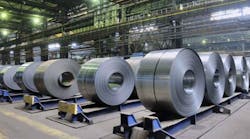Latest from Around the Web
Sponsored
Rising steel prices? How firms under contract can legally protect themselves
By STEPHEN E. YOCH, SMACNA legal counsel, Felhaber Larson, Minneapolis MN
April 2018
With the recent imposition of tariffs on imported steel and aluminum, steel prices are already increasing.
To minimize the risk of rising material costs and contractors’ potential liability, members of the Sheet Metal and Air Conditioning Contractors' National Association (SMACNA) should fully understand their contracts and ways to limit their exposure to price changes.
In many cases, if properly drafted, contract clauses, such as those discussed here, may limit the contractor’s liability. Understanding and limiting exposure to rising materials costs can mean the difference between a successful project and financial difficulties.
- Fixed price. Traditionally, contractors bid contracts on a “fixed” basis without any relief for increasing costs. If materials, like steel, are available—even if at a very high price—a contractor must provide them.
- Term limits on fixed price. If a contractor is subject to a fixed price contract, it is important that the contract limit the term of the fixed price provision. That is, if price is “fixed,” then the price should be “good” for a certain number of days. Thus, if the project is significantly delayed, the contractor does not bear the risk of increasing prices over the period.
- Cost-plus vs. escalation clause. An “escalation clause” should be distinguished from a “cost-plus” provision. A cost-plus contract inherently assumes that the cost of materials will be borne by the owner. That is, the owner, in a cost-plus contract, bears the risk of increasing materials costs. This represents the surest protection to the contractor against rising costs. In contrast, an escalation clause provides that an owner shall only bear the risk of changing materials costs if a certain percentage or amount of cost increases. Put another way, in a cost-plus contract, the owner bears all of the risk of materials price changes, whereas in an escalation clause, the contractor bears the risk up to a specified threshold.
- Force majeure clause. A force majeure clause is defined by Black’s Law Dictionary as a clause that "is common in construction contracts to protect the parties in the event that a part of the contract cannot be performed due to causes which are outside the control of the parties and could not be avoided by the exercise of due care." Similar clauses are also described as "Act of God" clauses. For this provision to apply to materials costs, it should have clear definitions of when price changes will be considered a “force majeure” voiding all or a portion of a contract.
- Impossibility/impracticability of performance. A contractor may be able to avoid its obligations to perform if obtaining materials is “impossible” or “impracticable.” These doctrines provide that a party may be excused from performing under a contract if it demonstrates that performance is truly “impossible.” The contractor must show that the materials were absolutely unavailable “at any price.”
- “Mistake” or “frustration of purpose.” Another potential way a contractor can avoid excessive material prices is by claiming “mistake” and/or “frustration or purpose.” This requires a showing that there was a fundamental misunderstanding between the owner and contractor regarding the contractual terms (like material prices). This argument is normally asserted as “defense” in a legal action and does not lend itself to contractual clauses.
SMACNA strongly encourages members to seek advice from local legal counsel, as the law of individual jurisdictions may vary, and the circumstances of an individual member’s situation may be different than discussed here.
For a more complete discussion, please read Contracts Bulletin No. 110, Shifting the Risk of Rising Material Costs, on SMACNA’s Project Management webpage.


